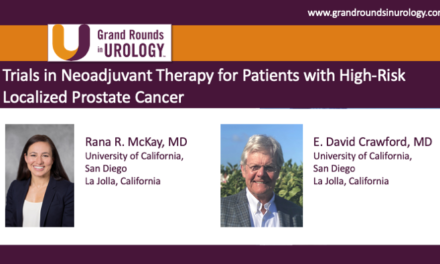Dr. E. David Crawford presented “Biomarkers: A Way Forward with Prostate Cancer Early Detection” at the 26th Annual Perspectives in Urology: Point-Counterpoint, November 10, 2017 in Scottsdale, AZ
How to cite: Crawford, David “Biomarkers: A Way Forward with Prostate Cancer Early Detection” November 10, 2017. Accessed Dec 2024. https://dev.grandroundsinurology.com/biomarkers-way-forward-prostate-cancer-early-detection/
Summary:
Dr. E. David Crawford, MD, provides an update on the impact of biomarkers and discusses the controversy about the early detection of prostate cancer
Biomarkers: A Way Forward with Prostate Cancer Early Detection
Transcript:
E. DAVID CRAWFORD: So in the next few minutes, I’m going to cover I think one of the most important topics in prostate cancers. That’s the impact of biomarkers and all this controversy about early detection of prostate cancer.
I bring you greeting from Colorado which is pretty close to here as you well know. This is the Aspen Valley and the Aspen’s changing. There is a Crawford County in Colorado, and there I am with my picture. Rocky Mountain high has a new meaning from when I grew up and John Denver. It has had a major impact on our state. Anyway, my disclosures are here and a number of the companies I consult for or speak are going to be covered in this presentation and their products.
Let’s go with the ARS question number one. This is a urine-based test to detect aggressive cases of prostate cancer. What is it: PCA3, 4K Score, SelectMDx, or PHI? Let’s have everybody vote on that. Okay, let’s see if that changes. Let’s go to the next one.
What percent of men have a PSA of less than 1.5 in a screening population? In other words, if you went out and picked up 50,000 PSAs that are run in your lab or whatever, 500,000, what percent are less than 1.5: A., less than 50 %, 2., less than 30 %, 3., greater than 70 %,or 4., greater than 80 %? We get Rocky Mountain High. All right, let’s see what everybody said. Okay, we’re going to have some fun with this talk. All right, let me get started.
I think there are several important needs in prostate cancer. One is that early detection, the controversies about that. We need to start with primary care physicians. They need a simple message. We’re going to focus on that in a minute. Second is an early detection of prostate cancer. We need to focus on men who have significant cancers that would benefit from treatment.
We really need to think beyond PSA. PSA screening, or early detection as I like to call it, has poor specificity. There are too many negative prostate biopsies that are done in the United States each year. We’ll talk about that. We are plagued with over detection and treatment of insignificant disease. We have these false negative biopsies. We have really incorrect risk stratification and sort of over-treatment of tumors that have a prolonged natural history of not progressing and impacting life expectancy of patients.
I think there is a way forward. There are a couple things I want to talk about. One is to integrate markers. I call those PCMs or prostate cancer markers. What these are are molecules that can be found in blood, tissue, or body fluids that are the sign of a normal or abnormal process, all right? Obviously, blood is easier than tissue. Urine is also easier than tissue. Some of these markers really need to be done on tissue, and some can be done on urine, and some can be done on blood. The excitement is that these markers have added a lot to our understanding of prostate cancer.
What we like to do is put these into compartments or buckets. The first bucket is where I’m going to spend my time. That’s on an initial biopsy. The goal here is not to find prostate cancer. The goal here is to find a significant prostate cancer. We’re going to talk about a couple of these markers in particular. One is the blood test called 4k score. The other one is the urine test called SelectMDx. I’ll mention also phi.
We’ll talk about this later in this meeting, men who have a negative biopsy, whom to read biopsy. Again, we have sort of the same players, 4k score, SelectMDx, and also another test called ConfirmMDx.
Genetic testing is important. We’ll be covering that too during this meeting—the inherited rates of prostate cancer, the implications of BRCA-2 positivity, and so forth.
Then we also still find, unfortunately, men who have Gleason 6 cancers, low grade, that are candidates for active surveillance. We’re not totally correct all the time. That’s where some of these other markers come in and play a role to help us determine who has an aggressive cancer.
We’ll hear also about, in this meeting, the role of some of these markers in men who’ve had a local treatment, primarily radical prostatectomy, who appear to be candidates for radiation or may not be candidates for radiation post-operatively. We have actual markers that help us determine who would benefit and who wouldn’t.
I look at this as a fox hunt. It’s sort of this whom to biopsy initially, rebiopsy, and treat. We’re trying to find the fox here with all of the dogs. How do we do that? They sort of, at a distance, all look the same.
Driving it back to men, here are four men with prostate cancer. One of these men has a potentially lethal prostate cancer. How do you differentiate these very low risk from the high-risk men?
I show this as sort of an analogy. Here’s a man. Here’s a bank. He comes in with dark glasses on. What’s his risk of being a bank robber? Well, it goes up when he has dark glasses on. If he comes in with a backpack, it goes up a little bit. If he has a walkie-talkie, it goes up a little bit. He comes in with a gun, that’s a major raiser of the risk of being a bank robber.
All of these things are variables. We put all these in our little think tank, and we say, okay, what’s the relative risk. Sometimes you have a whole bunch of variables that mean something, and sometimes you have ones that are very important. The importance of this is that none of these tests are perfect, okay? If anything was 100 % sensitivity and specificity, I wouldn’t believe it. They all add a little bit. The guy comes in, and he’s got a badge. That wipes it all out. These things are all important, but nothing’s perfect.
Every time I give a talk on markers, somebody always says, well, I did this marker on this person, and it said he was low risk, and he had metastatic disease. Okay, it happens. They’re not perfect. We do the best we can, and some of these are up in the high 90 percents.
It’s called precision medicine or personalized diagnosis. That’s what they’re doing now. They’ve done this in breast cancer and melanoma for many years. We’re starting to do that in prostate right now where we have things that go beyond Gleason score PSA and so forth to give us some relative risk of the person harboring a cancer or having a recurrence or needing a biopsy.
We heard about the US Services Preventive Task Force. They gave this a D. That was a number of years ago. Now it’s a C. Well, when I got into medical school, it wasn’t much difference if you had a D or a C. You didn’t get in. I don’t think C is that much of a change. What we need to do is to rethink this whole thing.
The US Services Preventive Task Force, I ask people, who are they? Oh, they’re a bunch of bad guys and ladies that are against screening. No, what they are actually—they did us a favor. The US Services Preventive Task Force was implemented by an act of Congress several decades ago to advice family practice physicians on treatment outcomes, and provide guidelines, and things like that. What blood pressure do you treat—and so forth and so on, what cholesterol, and so forth.
Here’s the statement I think is very strong and is meaningful today. Using PSA alone to guide prostate biopsy decisions for the most part should end—not unless PSA is 15 or 20. Most of the PSAs we do—and I’ll show you this is men—are sort of in that grey zone between one and a half, two and a half, to six or seven, okay? How do we determine when to do a biopsy? It shouldn’t be on PSA alone today. We want to find aggressive cancers. We need tools to detect these that are risk stratified to reduce unnecessary biopsies and over detection of indolent disease.
All right, what percent of PSAs ordered in the United States are ordered by urologists? Well, when I ask urologists this question, most of them.
Wrong, most of the PSAs—and I thank Matt Rosenberg for this work—are ordered by family practice and internal medicine doctors here. Only 6 % are ordered by urologists, and 1.3 % by hematologists/oncologists. If you’re going to deal with this problem, where do you start? You start with the family practice doctors. Educate them.
The problem is we confuse the heck out of them. What we do is we say family practice doc, we have a PSA cut-off of 1.5, 2.5, or 4. We have a PSA velocity, PSA density, age-specific PSA, percent free PSA, complex PSA, Phi, PCA3, SelectMDx, and 4kscore. They go, oh, help. They have enough to remember. They need a simple message. They need to know when to refer these men to urologists.
What I did a number of years ago is went to the Henry Ford database. I knew the answer before I went there, but I just wanted to substantiate it. Is there a PSA cut-off below which you have a low risk of having prostate cancer. The answer is that when it was less than 1.5, less than 0.5 % of men, developed a clinical prostate cancer that was then diagnosed within the next 5 years. Most of those were not significant. Whereas, if it was 1.5 to 4, not above 4, 1.5 to 4, the risk went up substantially, almost 20-fold if you were African American and 15-fold if you were Caucasian. The area under the curve here was pretty good. It was 0.87.
All right, we published this in Urology with a group of experts from around the country, including Johns Hopkins, Memorial, MD Anderson, NCI, and Cleveland Clinic. It was a tough paper to get together. It did win the best paper of the year last year.
What it said was this cut-off at 1.5 may be the way forward. The next question was, oh, how many men out there are going to—and this was the IRS question—have PSAs of greater than 1.5? Are you going to over flood the market? We went to bioreference labs, and they gave us this data of men that had PSAs done in their labs, almost 500,000. What we see here is that 73 % had a PSA of less than 1.5. That means you’re dealing with about one in four men in this grey zone.
The way forward is I think that—and Matt Rosenberg and I have talked about this a lot—is family practice doctors. Everybody says shared decision making, okay? It isn’t going to happen in prostate cancer. I’m telling you that right now. If it does, I think the person is bias one way or the other because they’re not going to spend 15 minutes talking about this. They got more important things to talk about—hypertension, obesity, smoking, diabetes, all these other things, not this controversy about prostate cancer.
We need two things, a simple message to them—because most family practice doctors I think believe there is some value in early detection of prostate cancer, okay? I see a lot of them that I did PSA testing on, okay? I think they believe in it. The question is all the controversy, lawsuits, things like that.
What they need is, when they see you, do they get informed decisions to check your blood pressure? Do they get informed decision to check your cholesterol? Do they tell you if I check your cholesterol and I put you on a statin, you might have rhabdomyolysis, renal failure, and die? No? Do they tell you if I check your blood pressure, you might be on an antihypertensive, fall down, crack your head, and have a subdural, and die? They don’t tell you. They talk to you when the tests are abnormal.
Why isn’t prostate cancer the same way? If the PSA is abnormal, then talk to the person. I think that makes sense. That resonates with a lot of people that informed decision doesn’t happen all the time. It happens after the test is abnormal. That’s the same thing.
What it is is that PSA is a surrogate for the risk of prostate cancer. The other thing is when they draw a blood sugar on you and it’s elevated, do they start you on insulin or metformin? No, they do another test. It’s called an A1c hemoglobin. You come in and have an abnormal EKG. Do they send you to get a bypass right away? No, they do a vessel study. If you have an elevated PSA, should you do a biopsy? No, you should do the next layer. We’re going to talk about basically two tests, 4Kscore and SelectMDx.
Here is the algorithm. The patient comes in with an elevated PSA. He is referred to a urologist where you have a family practice person like Matt Rosenberg. Then you do the next level of tests.
PSA screening, there are 20 million PSAs done every year. Five million of them are elevated. We only diagnose 108,000 men. We need to focus on diagnosing less men, but men that have a higher risk of having a Gleason pattern 7 and above.
Let’s talk about the 4K test. 4K OPKO is out there. They’ve got a lot of good data. It’s a test that looks at four kallikreins. The magic ingredients probably are hK2 and intact PSA or hK2 here. Hans Lillia has worked on that—a good friend of mine—for many years. They combine that with the DRE, and biopsy status, and things, and give you a relative risk.
This is sort of the same slide, but these are all the components that exist of PSA. PSA is percent free PSA, complex PSA, bound PSAs, all kind of PSA isoforms. They’ve picked on hK2 and these other in a formula that comes up with a relative risk of you having cancer, okay?
What it said was this cut-off at 1.5 may be the way forward. The next question was, oh, how many men out there are going to—and this was the IRS question—have PSAs of greater than 1.5? Are you going to over flood the market? We went to bioreference labs, and they gave us this data of men that had PSAs done in their labs, almost 500,000. What we see here is that 73 % had a PSA of less than 1.5. That means you’re dealing with about one in four men in this grey zone.
Then you get a report back like this that tells you your relative risk and where you see. What we see with a lot of these tests, they slide back and forth and give you sort of a slide roll.
The 4K test also is a good test to predict the probability of distant metastases in 20 years. In fact, what happens is what we see here as that if your 4K test is low versus high, there’s a big difference in the rate of metastatic disease.
SelectMDx is a urine test that looks for two genes associated with aggressive prostate cancer. These tests are both focused on risk factors. 4K uses what we just talked about before, the kallikreins and so forth. This uses urine. It’s basically developed by the guy that developed the PCA3 score, Jack Schalken.
What you have here is pretty good, a 99 % negative predictive value for high-grade Gleason 8s and 98 % for 7. This test is predicated on a very high negative predictive value, okay? That’s good. If somebody gets a test and it’s negative, you have a low risk of having prostate cancer.
If you look at area under the curve and compare it to the prostate calculator and other things there is, there’s a big difference here. Also, some of the work done here is the SelectMDx risk profile for no cancer, Gleason 7, there’s no overlap. It’s not perfect again for some of the Gleason 6s when it’s positive. We have, again, a test that’s very helpful when it’s negative. When it’s positive, what they do now is they give you the relative risk of having Gleason 6 and 7. Again, with all these tests, it’s the bank robber thing in identifying the man.
This is a report you get. I like to get the very low risk. This is the high risk, and it gives you the relative risk of having a Gleason 7 or above.
What we have here is a table—and I’ll show you a website where we have all this stuff in a minute. It goes by phi, 4K, Progensa, and SelectMDx. Gleason 6, we want to eliminate it in 2017.
This is this website that we have, www.pcmarkers.com. I encourage you to look at it. All this information is in there. Downloadable stuff is in there. I brought some cards I’ll give you. You can print up cards from there. When you see a patient, you order 4K or Select or Confirm, you can give it to the patient.
ABOUT THE AUTHOR
Researcher-physician E. David Crawford, MD, has devoted his career in medicine to educating the public about men's health issues and finding effective techniques and procedures to address prostate cancer, the most common malignancy affecting men in the United States.
He is currently a Professor of Urology at the University of California, San Diego, and emeritus distinguished endowed Professor of Surgery, Urology, and Radiation Oncology, and Head of the Section of Urologic Oncology at the University of Colorado Anschutz Medical Campus in Aurora, Colorado. Dr. Crawford received his medical degree from the University of Cincinnati and his postgraduate training included an internship and residency in urology at the Good Samaritan Hospital in Cincinnati. He subsequently completed a genitourinary cancer fellowship at the University of California Medical Center in Los Angeles.
Dr. Crawford is an internationally recognized expert in benign prostate hypertrophy, urologic cancers, and in particular, prostate cancer. He has conducted research in the treatment of advanced bladder cancer, metastatic adenocarcinoma of the prostate, hormone-refractory prostate cancer, and other areas of urological infections and malignancies. He has authored or coauthored over 810 scientific articles, has published seven textbooks, authored over 60 book chapters, and provided more than 2,200 educational talks for patients and physicians.
In an effort to raise public awareness about prostate health, Crawford in 1989 founded the Prostate Conditions Education Council (PCEC). The non-profit organization is comprised of a consortium of leading physicians, health educators, scientists, and men's health advocates. PCEC's advocacy for free or low-cost prostate screening has affected the lives of millions of American men. He currently chairs the PCEC.
Crawford is an active member of many national and international organizations, including the American Society of Clinical Oncology, the American Urological Association (AUA), and the American Association for the Advancement of Science. Within the AUA, he has been a member of the Committee to Study Urologic Research Funding and the prostate cancer clinical trials subcommittee. Crawford served on the board of governors, the scientific advisory board of the Southwest Oncology Group, and was chairman of the Genitourinary Cancer Committee for 27 years. This group is the largest clinical trials group in the world.
Crawford's involvement in the national prostate cancer arena has been widely recognized. He has received many honors and awards, including the CAP Cure Annual Award for Scientific Presentation in 1999 In 1997, he was presented with a 'Freddie Award" at the AMA International Health and Medical Film Competition for the program, ITV: The Cutting Edge Medical Report (Prostate Cancer: Understanding, Diagnosing, and Defeating), which Crawford hosted with special guest, retired General Norman Schwarzkopf.
Crawford again won a prestigious 'Freddie Award" 5 years ago... He is a member of Best Doctors of America and was named Healthcare Provider of the Year in the Denver Metro area by the Denver Business Journal.
He has been recognized as one of the Best Doctors of America for the past two decades and is recognized as one of the top 20 urologists in the country, for men, by Men’s Health Magazine. In 2018 he received the honor of being named the Distinguished Alumnus of the Year from the University of Cincinnati School of Medicine. In May of 2019, he received the Presidential citation from the American Urological Association recognizing for his “tireless role in genitourinary cancer research that has benefited countless urologic cancer patients.” He accepted the position of Editor in Chief of Grand Rounds in Urology in June of 2019. In 2021, he was the recipient of the Merle Stringer, M.D. annual award for excellence in medicine by the Florida State Medical Association.





